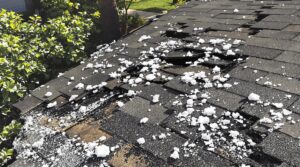Insurance companies enforce strict deadlines for hail damage claims, with time limits varying considerably by state and policy type. Most states allow between six months to two years from the storm date, while some policies require notification within 60-90 days of damage discovery. Colorado permits one year, while Texas allows two years to file. Proper documentation through photos, videos, and detailed records is essential. Understanding specific policy requirements and deadlines can mean the difference between claim approval and denial.
Key Takeaways
- Most insurance policies require immediate notification of hail damage, with formal claims typically due within one year of the incident.
- State-specific deadlines vary significantly, with Colorado allowing one year and Texas permitting two years from damage date.
- Insurance companies may require damage reporting within 60-90 days of discovery, regardless of state filing deadlines.
- Document all damage with timestamped photos and maintain organized records of correspondence with insurance providers.
- Missing claim deadlines can result in complete coverage denial and leave homeowners fully responsible for repair costs.
Understanding the Basics of Hail Damage Insurance Claims
Filing a hail damage insurance claim requires careful attention to documentation and process management. The claim process begins with thorough documentation of all affected areas through photographs and videos, capturing both detailed close-ups and extensive wide shots of the damage.
Property owners must review their insurance policies to understand coverage specifics, including deductibles and exclusions.
Insurance terminology plays a critical role in the process, particularly when distinguishing between dwelling coverage and optional endorsements. Most homeowners' policies include hail damage under dwelling coverage, which encompasses repairs to roofs, siding, and other structural elements.
Understanding coverage limits and any specific deductibles for hail damage is essential before proceeding with the claim.
Successful claims require prompt reporting to insurers, professional repair estimates from qualified contractors, and organized documentation for the adjuster's review.
Property owners should also familiarize themselves with policy exclusions, such as cosmetic damage limitations, to maintain realistic expectations throughout the claims process.
The claims processing time can vary significantly depending on damage complexity and weather impact assessments.
State-by-State Time Limit Variations
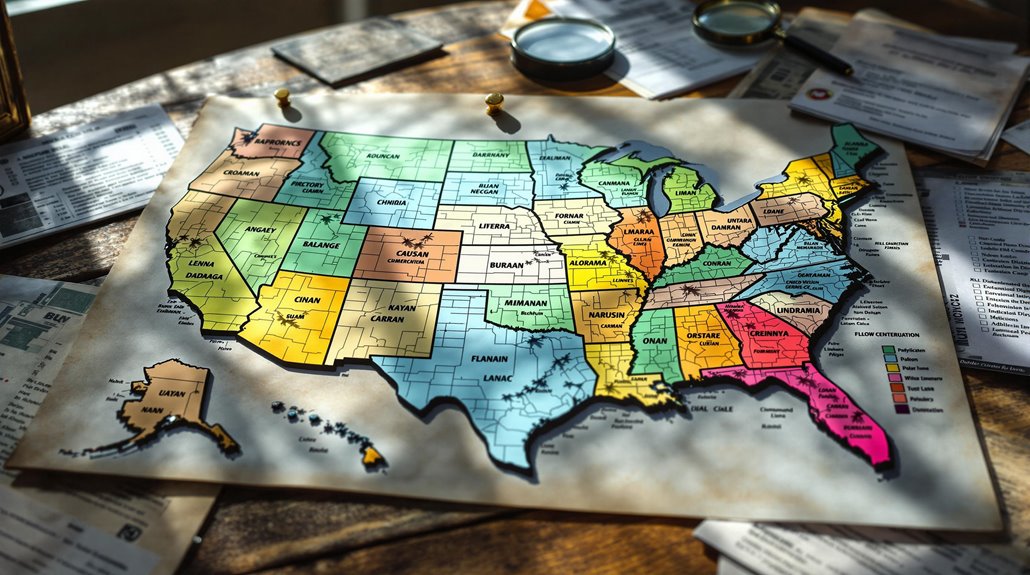
Insurance claim deadlines for hail damage exhibit significant variations across different states, with time limits ranging from six months to two years depending on state regulations and individual policy terms.
Colorado typically allows one year from the storm date to file a claim, while Texas permits a two-year filing window from the date of the covered event.
State-specific regulations and local insurance requirements create a complex framework of deadlines that property owners must navigate when filing hail damage claims.
Common Regional Time Frames
The legal time frames for submitting hail damage claims vary considerably across different states, with standard periods ranging from six months to two years after the incident. Understanding regional policy differences is vital to avoid common filing mistakes, as deadlines can be strictly enforced. While most insurers allow one year from the storm date, some policies mandate reporting within 60 or 90 days of damage discovery.
| State | Standard Time Frame | Special Provisions |
|---|---|---|
| Texas | 2 years | Extended reporting options |
| Colorado | 1 year | Case-by-case extensions |
| Other States | 3-24 months | Policy-dependent terms |
Insurance carriers may grant extensions for delayed damage discovery, typically requiring written requests submitted 30 days before the deadline. State-specific regulations ultimately govern these timeframes, making local compliance essential for successful claims processing. Working with a public adjuster can help identify potential claim pitfalls and ensure timely filing within required deadlines.
Crucial State Law Differences
While every state maintains unique regulations for hail damage claims, significant variations exist in statutory filing deadlines across different jurisdictions.
Colorado enforces a one-year limitation from the date of the storm, while Texas allows policyholders two years to file their claims. These state regulations directly influence how insurance policies are structured and enforced within each jurisdiction.
The variation in deadlines can be substantial, ranging from as brief as three months to as long as two years, depending on the state and specific policy terms.
Some states have implemented specialized provisions for areas prone to hail damage, incorporating flexibility for cases involving delayed discovery of damage.
Understanding these jurisdictional differences is critical, as failing to meet state-mandated deadlines can result in claim denial and significant financial consequences.
Working with public adjusters can help ensure policyholders meet critical filing deadlines while maximizing their settlement amounts.
Local Insurance Filing Deadlines
Across the United States, filing deadlines for hail damage insurance claims exhibit substantial variation, with states implementing diverse statutory requirements and time limitations. Local regulations dictate specific timeframes, exemplified by Texas's two-year statute of limitations and Colorado's three-year limit for claim submissions.
Claim procedures differ between commercial and residential properties, with commercial claims typically allowing two years from the incident date, while residential claims often require submission within one year.
Insurance policies may contain provisions for delayed discovery scenarios, potentially extending standard filing windows. Understanding these variations is critical, as policy terms can override state-mandated timeframes.
The timing of claim submission remains paramount, as delays can result in coverage denials or complications in the settlement process. Working with public adjusters can increase claim settlements by 30-50% while ensuring compliance with local filing deadlines.
Key Deadlines for Homeowners Insurance Claims
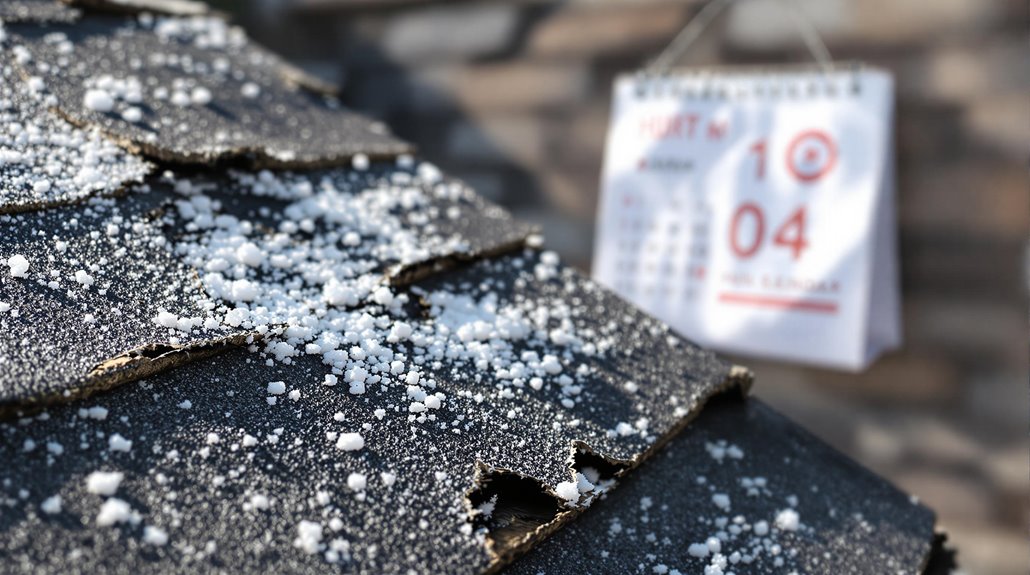
Understanding hail damage insurance claim deadlines proves crucial for homeowners seeking compensation for storm-related property damage. Insurance policies typically require immediate claim notification following a hailstorm, with specific filing time limits varying between companies and states.
While most insurers allow between 30 days to three years to submit claims, hail damage claims generally must be filed within one year of the incident. Filing strategies should account for state-specific regulations, which commonly mandate submission periods ranging from six months to two years.
Each insurance policy contains distinct deadlines that policyholders must observe to maintain coverage eligibility. Failure to meet these prescribed time limits can result in claim denials, reduced compensation, or increased out-of-pocket expenses.
Insurance providers implement these deadlines to facilitate prompt damage assessment, prevent fraudulent claims, and guarantee timely property repairs. Homeowners should review their policies carefully to understand applicable filing deadlines and notification requirements.
Consulting public insurance adjusters can help maximize settlements and ensure compliance with complex filing deadlines.
Critical Time Frames for Auto Insurance Claims

The critical time frames for filing auto insurance claims vary considerably across insurance providers and state jurisdictions.
Standard claim filing windows typically range from 30 days to several months after damage occurs, with some insurers requiring notification within 24 hours of an incident.
State-specific statutes of limitations establish broader legal frameworks, from West Virginia's two-year limit to Wyoming's four-year allowance for both property damage and personal injury claims.
Insurance protocols differ among providers, with companies like Liberty Mutual mandating claim submission within 20 days of a collision. States such as New York and California enforce strict reporting requirements, particularly for accidents involving injuries.
Failing to meet these deadlines can result in serious consequences, including claim denial and loss of compensation rights.
The degradation of evidence and difficulty in proving damage causation make prompt reporting essential.
Individual policy documents remain the authoritative source for specific time requirements.
Essential Steps to Meet Filing Deadlines

Meeting filing deadlines for hail damage insurance claims requires a systematic approach involving documentation, policy review, and timely communication with insurers.
Following proper filing procedures begins with thoroughly documenting all damage through clear photographs and detailed lists, while recording the exact date of the hailstorm.
Key documentation tips include maintaining organized records of all correspondence with the insurance provider and preserving receipts for temporary repairs.
Policyholders must review their insurance terms to identify specific time limits and claim requirements.
The process involves promptly reporting damage through appropriate channels, whether online portals or direct contact, while providing thorough information about the incident.
To guarantee compliance with deadlines, claimants should prepare all necessary documentation for the adjuster's review, maintain proactive communication throughout the process, and carefully track submission timeframes.
This organized approach helps meet filing requirements while maintaining a clear record of the claim's progression.
Common Pitfalls When Filing Late Claims
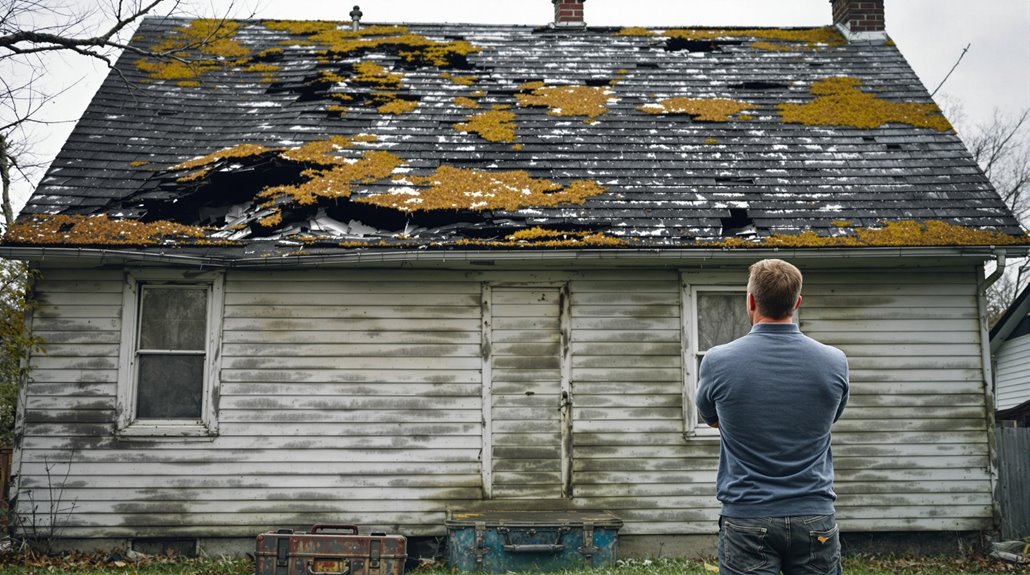
Filing hail damage claims past the deadline can result in outright coverage denial, leaving property owners fully responsible for repair costs.
Late claims that are partially approved often lead to reduced settlements and increased future premiums, creating long-term financial strain on policyholders.
The extended time between damage occurrence and repairs can exacerbate structural issues, potentially compromising the quality and effectiveness of eventual repairs.
Coverage Denial Consequences
Submitting a hail damage insurance claim after established deadlines can trigger severe financial consequences for homeowners. Claim denial often results in property owners bearing the complete financial burden of repairs, while late submissions that are accepted may face reduced coverage implications. Additionally, homeowners may find it challenging to identify specific wood roof hail damage signs, which can further complicate the claims process. Ignoring the presence of these signs can lead to ongoing damage and increased repair costs over time. Therefore, it’s crucial for property owners to document any hail damage promptly and thoroughly to support their claims and avoid the pitfalls of late submissions.
These outcomes can greatly impact both immediate repair costs and long-term insurance expenses.
Key consequences of coverage denial include:
- Full out-of-pocket payment for all repair and restoration costs
- Potential increase in future insurance premiums
- Reduced likelihood of coverage approval for subsequent claims
- Loss of proper damage assessment documentation
Insurance providers strictly enforce filing deadlines to guarantee accurate damage evaluation and maintain claim legitimacy.
Understanding and adhering to both state regulations and policy-specific time limits is essential for protecting homeowners' financial interests and maintaining thorough coverage benefits.
Financial Impact Over Time
When homeowners delay filing hail damage insurance claims, they expose themselves to a cascade of escalating financial consequences that compound over time.
Proper financial planning becomes compromised as initial damage assessment costs increase due to secondary issues like water leaks and structural deterioration. Insurance companies may reduce payouts or deny claims entirely when damages cannot be clearly attributed to specific hailstorms, forcing homeowners to bear substantial out-of-pocket expenses.
Late claim filing often results in higher insurance premiums, as policyholders may be categorized as high-risk clients.
Additionally, unaddressed hail damage can greatly decrease property resale value.
The cumulative effect of delayed repairs, reduced insurance compensation, and increased premiums creates a substantial financial burden that could have been mitigated through prompt claim submission.
Repair Quality Complications
Delaying hail damage insurance claims greatly complicates the repair validation process and compromises repair quality outcomes. Late assessments make it challenging to authenticate claim legitimacy, as distinguishing between hail-induced damage and other sources becomes increasingly difficult over time. The complexity of validation often results in partial coverage or claim denials, directly affecting repair quality standards.
- Documentation challenges impede accurate damage assessment and proper repair planning.
- Pre-existing damage disputes arise when multiple incidents occur before claim processing.
- Repair quality suffers due to increased deterioration of initial damage.
- Late inspections may miss critical damage points, leading to incomplete repairs.
This validation complexity affects both immediate repairs and future claim processes, potentially compromising the vehicle's structural integrity and overall repair quality.
Insurance providers require thorough documentation to maintain claim legitimacy, which becomes progressively more difficult with delayed reporting.
Documentation Requirements Within Time Limits

Proper documentation serves as the foundation for successful hail damage insurance claims within required time limits. Following documentation best practices involves systematically photographing and videoing all affected areas, maintaining detailed records of damages, and preserving receipts for temporary repairs.
Insurance companies require thorough documentation that clearly establishes the date and extent of hail damage. Claim submission tips emphasize the importance of organizing materials chronologically and including essential components such as timestamped photos, detailed damage lists, and contractor estimates.
Property owners must document additional expenses related to the claim, including temporary housing costs or business interruption losses. The claims process requires working closely with adjusters during field inspections while providing all requested documentation promptly.
Understanding state-specific requirements and policy timeframes is vital, as these vary by jurisdiction and insurer. Proper documentation not only supports claim validity but also helps prevent potential disputes during the settlement process.
Legal Implications of Missed Deadlines
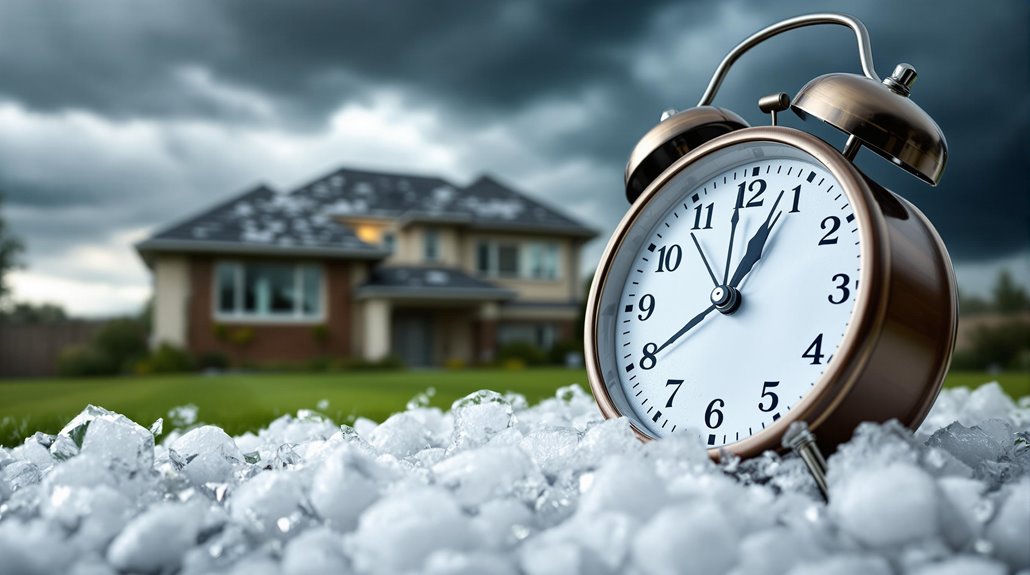
The legal consequences of missing insurance claim deadlines can be severe and far-reaching for property owners. When claim filing deadlines are missed, insurance companies may exercise their right to deny coverage, leaving policyholders responsible for repair costs.
State regulations establish specific time frames, which vary by jurisdiction, with some states allowing up to two years from the date of the hail damage event.
Delayed claims can result in multiple adverse outcomes:
- Automatic denial of coverage with no option for reconsideration
- Increased repair costs due to progressive damage and deterioration
- Difficulty proving the direct relationship between hail and property damage
- Reduced likelihood of successful legal recourse
While state regulations provide consumer protections, and policyholders maintain the right to fair claim processing, missing established deadlines considerably compromises these protections.
Public adjusters can assist in steering the claims process, but their effectiveness diminishes when time limits have expired. Insurance companies are only obligated to process claims submitted within designated time frames.
The Benefits Of Consulting A Public Adjuster

Public adjusters offer professional expertise in handling hail damage insurance claims through their extensive knowledge of policy terms, coverage limits, and claims procedures.
Their objective assessment methods and documentation protocols help guarantee accurate damage evaluations while building stronger cases for compensation.
The involvement of a public adjuster often results in expedited claim processing and statistically higher settlement amounts compared to claims filed without professional representation.
Expertise In Insurance Claims
When managing complex insurance claims for hail damage, consulting a public adjuster offers significant advantages due to their specialized expertise and extensive understanding of insurance policies.
Their claim strategies encompass thorough knowledge of insurance procedures, regulations, and policy interpretation. Public adjusters possess the adjuster qualifications necessary to navigate intricate claims processes while ensuring policyholders receive maximum benefits under their coverage.
- In-depth understanding of insurance policy terminology and fine print details
- Expertise in insurance claim laws and regulatory requirements
- Professional knowledge of proper damage documentation methods
- Advanced comprehension of insurance company assessment procedures
Their technical proficiency enables them to interpret complex policy language, identify covered damages, and execute effective documentation strategies.
This expertise proves invaluable when challenging insurance company assessments and securing appropriate compensation for hail damage claims.
Objective Damage Assessment
Professional damage assessment through public adjusters provides an unbiased foundation for successful hail damage claims. These licensed experts conduct thorough evaluations to identify both visible damage and underlying issues that may affect property integrity. Their systematic approach guarantees insurance accuracy through extensive documentation and detailed cost estimates.
Public adjusters counter potential underestimation by insurance company representatives through methodical damage evaluation processes. They examine all affected areas, prepare detailed reports, and compile supporting evidence to strengthen claim credibility.
Their expertise in policy interpretation enables them to identify coverage parameters and negotiate effectively with insurers. By maintaining objectivity throughout the assessment process, public adjusters help secure fair settlements that reflect the true extent of hail damage, preventing underpayment and expediting claim resolution.
Streamlined Claim Process
Engaging the services of a public adjuster greatly streamlines the insurance claim process for hail damage victims. Through professional claim efficiency and systematic paperwork management, public adjusters handle all aspects of documentation while serving as expert representatives throughout the process.
Their extensive understanding of insurance policies and deadlines guarantees accurate submission of claims within required timeframes.
- Manage all communication with insurance companies, reducing administrative burden
- Review and complete complex documentation with technical precision
- Conduct thorough damage assessments and prepare detailed cost estimates
- Navigate potential disputes and negotiate settlements effectively
Public adjusters streamline the process by combining their expertise in policy interpretation with efficient documentation practices.
Their involvement minimizes delays, prevents errors, and helps secure fair compensation while reducing the time commitment required from policyholders.
Higher Claim Payouts & Settlements
As policyholders seek maximum compensation for hail damage, consulting a public adjuster greatly increases the likelihood of higher claim payouts and settlements.
Public adjusters work independently on behalf of policyholders, implementing proven claim strategies to maximize recovery values through detailed property assessments and documentation.
These professionals excel in policy negotiations with insurance companies, leveraging their expertise to identify overlooked damages and challenge underestimated repair costs.
Their extensive understanding of insurance policies enables them to prepare thorough claim packages while maneuvering through complex procedures and deadlines.
Since public adjusters typically earn a percentage of the recovered amount, their interests align directly with achieving the best settlements for policyholders.
Their involvement also helps mitigate potential premium increases while ensuring fair compensation for all documented damages.
About The Public Claims Adjusters Network (PCAN)
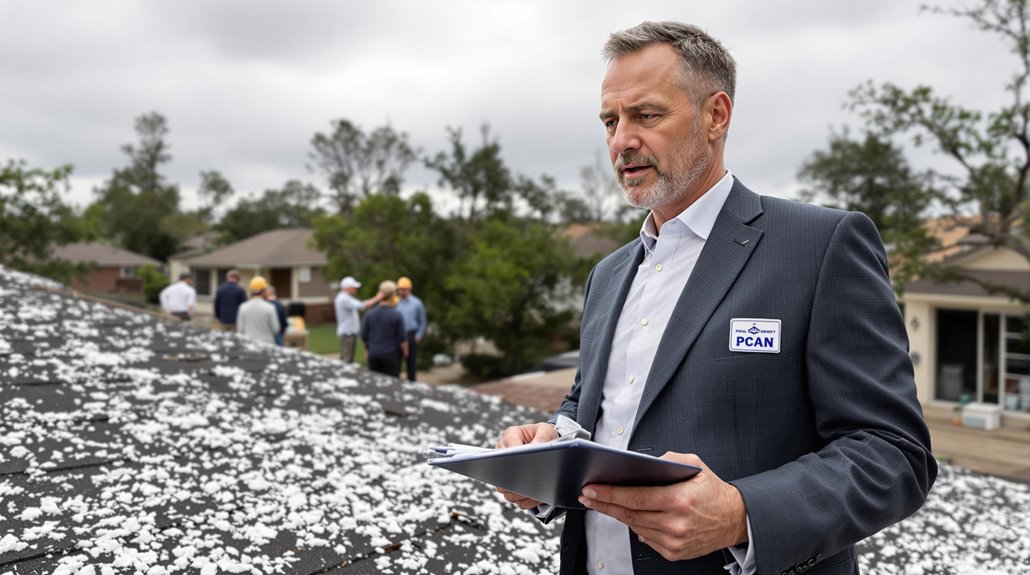
The Public Claims Adjusters Network (PCAN) represents a thorough alliance of licensed insurance claim professionals who specialize in representing policyholders during insurance claims processes. This network delivers extensive claims handling solutions through experienced adjusters and dedicated support services, offering significant public adjuster benefits to policyholders facing complex insurance claims.
The claims network advantages include access to wide-ranging expertise and professional guidance throughout the entire claims lifecycle, ensuring favorable outcomes for policyholders dealing with hail damage and other insurance matters.
- Professional teams providing empathetic service and technical expertise in policy interpretation
- Extensive suite of solutions including daily adjusters and specialized CAT services
- Tailored approaches for unique claim challenges and documentation requirements
- Strong emphasis on regulatory compliance and industry standard adherence
PCAN's structure enables efficient claim management while maintaining high-quality service standards. This helps policyholders navigate complex insurance processes and maximize their claim settlements through expert negotiation and thorough documentation.
Frequently Asked Questions
Can Multiple Hail Damage Claims in One Year Affect My Insurance Rates?
While insurers claim to understand nature's unpredictability, claim frequency impact greatly affects rates, with multiple hail damage claims typically resulting in substantial insurance premium adjustments within a single year.
Does My Mortgage Company Need to Approve Hail Damage Claim Payments?
Yes, mortgage companies require approval of insurance payments for hail damage claims when they have a financial interest in the property, as they are typically listed as co-payees on claim checks.
Will Insurance Cover Temporary Repairs While Waiting for Permanent Fixes?
Insurance policies typically cover necessary temporary repairs to prevent additional damage while awaiting permanent fixes. Coverage details vary by policy, but emergency measures must be reasonable and properly documented.
Can I Choose My Own Contractor for Hail Damage Repairs?
Like choosing a noble steed, policyholders generally maintain the right to contractor selection for hail damage repairs. Insurance companies may provide recommendations but cannot mandate specific contractors while ensuring repair quality standards.
Are DIY Repairs Covered Under Hail Damage Insurance Claims?
Insurance policies typically exclude DIY repair coverage for hail damage. Most insurers require professional repairs to meet specific guidelines and may deny claims involving unauthorized DIY repair attempts.
References
- https://www.vosslawfirm.com/blog/time-limit-in-texas-for-hail-damage-insurance-claims.cfm
- https://www.allstate.com/claims/catastrophe/wind-and-hail
- https://www.lettrlabs.com/post/hail-damage-insurance-claim-time-limit
- https://www.gedlawyers.com/faqs/how-long-do-you-have-to-claim-hail-damage-on-a-car/
- https://www.angi.com/articles/dos-and-donts-hail-insurance-claims.htm
- https://www.insuranceclaimrecoverysupport.com/hail-damage-insurance-claims/
- https://www.insuranceclaimrecoverysupport.com/hail-damage-covered-by-insurance/
- https://www.oneclickcode.com/blog/how-does-a-hail-damage-claim-work
- https://holladaygrace.com/blog/how-long-do-i-have-to-file-a-hail-damage-insurance-claim
- https://www.raiznerlaw.com/blog/how-long-do-you-have-to-file-a-commercial-hail-damage-claim-for-your-roof/
